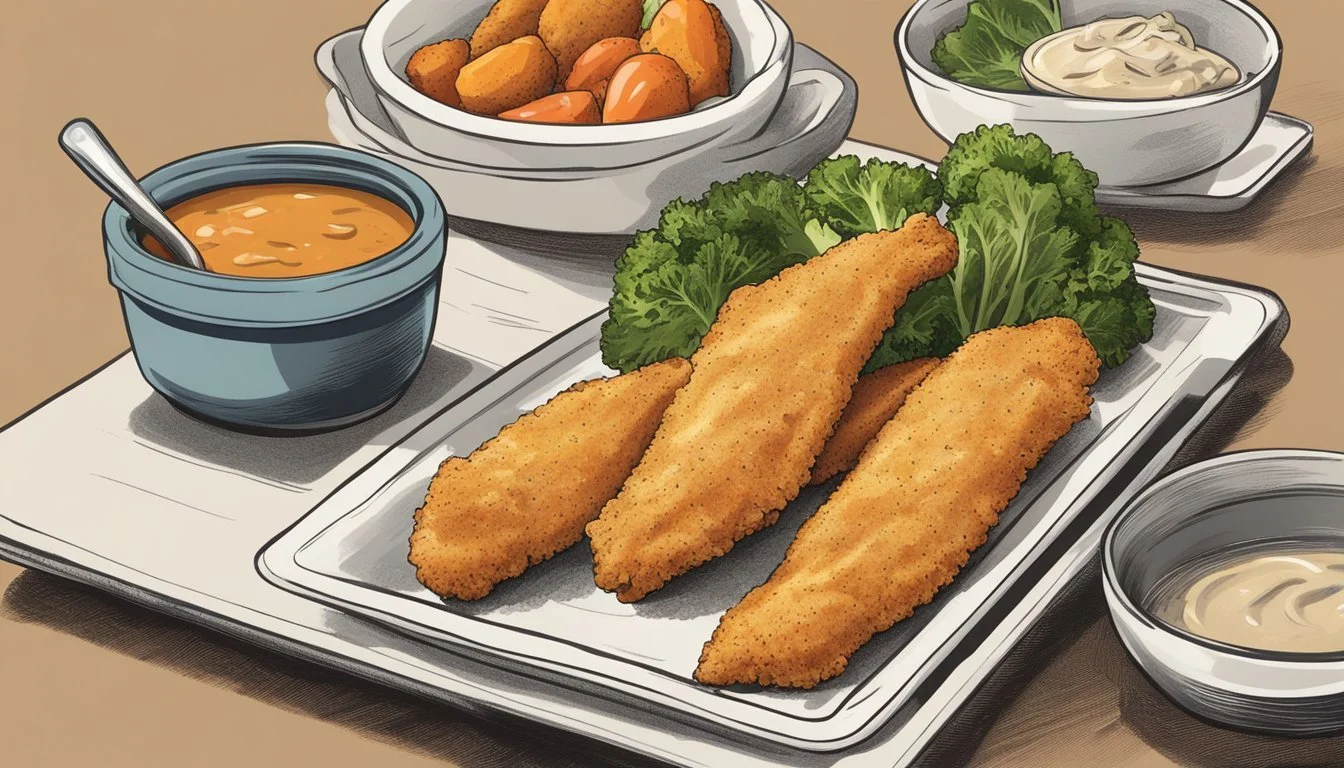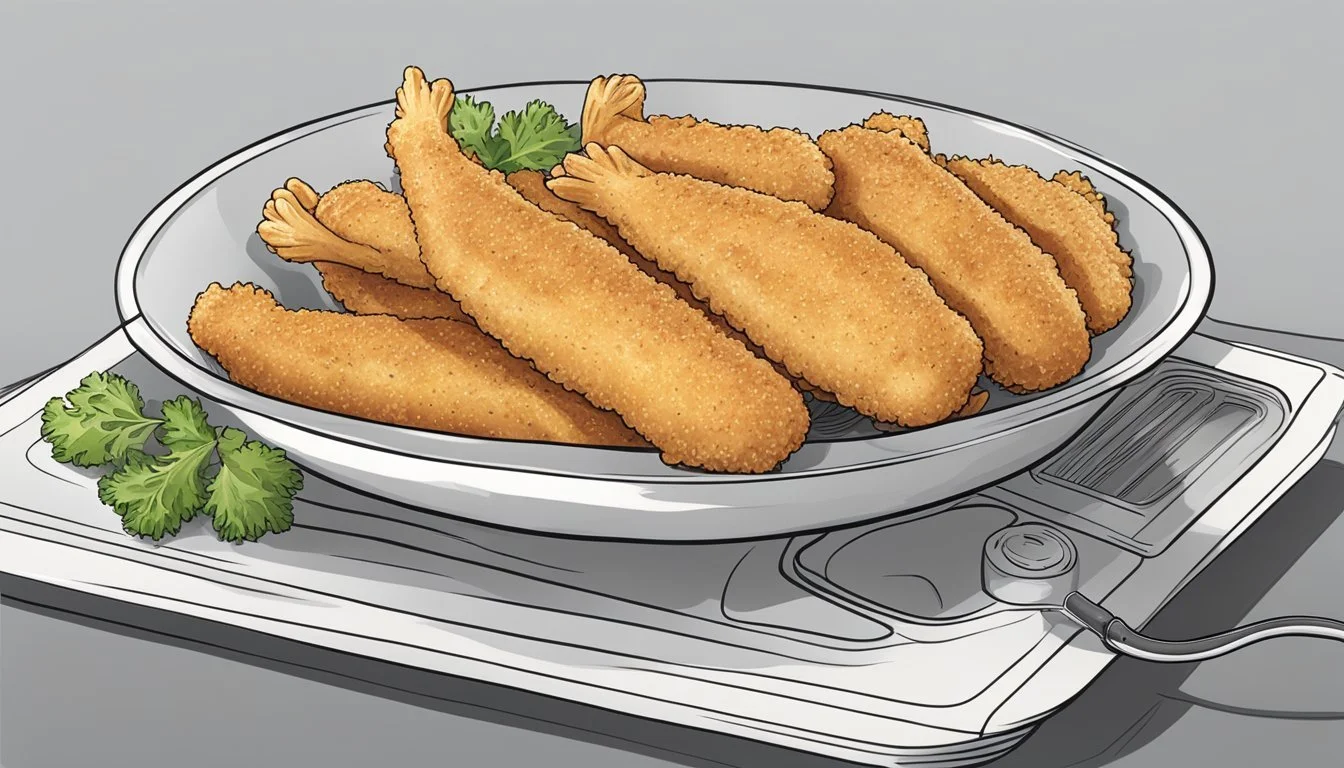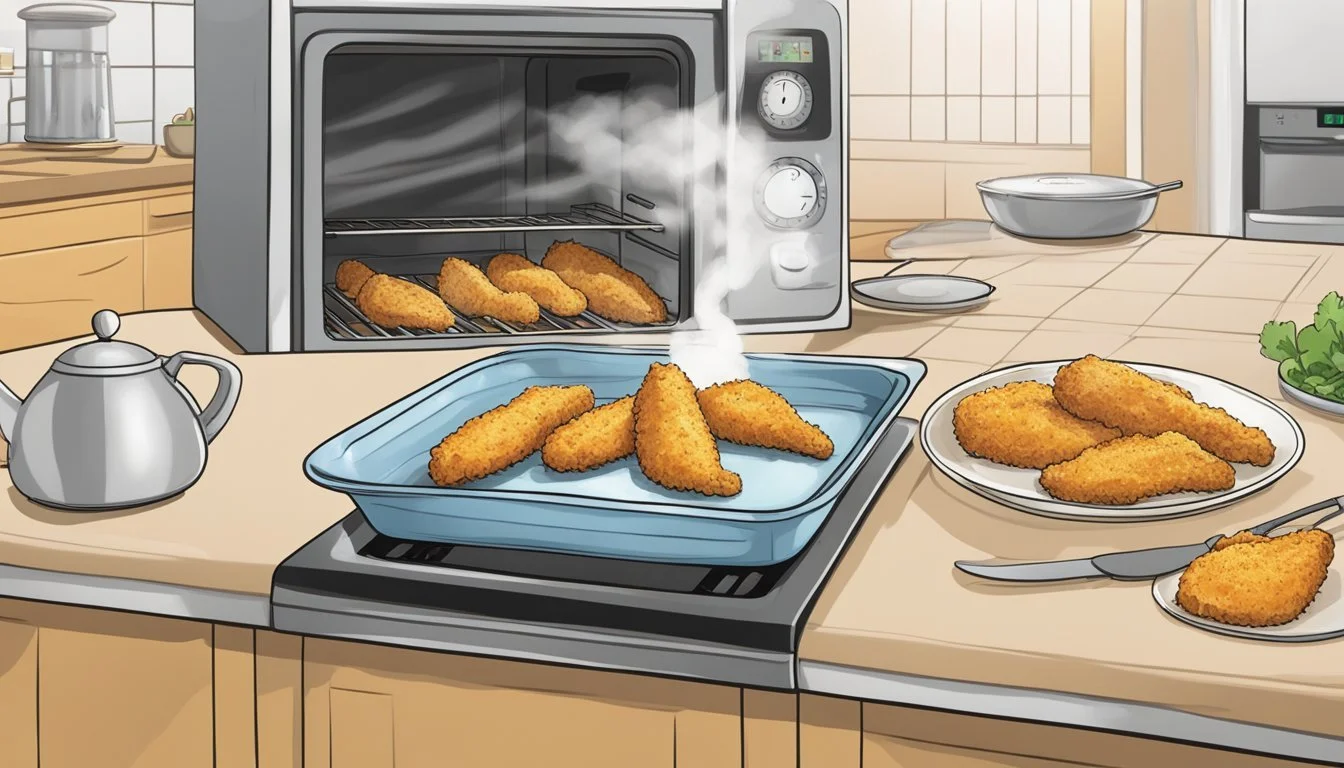How to Reheat Gluten-Free Chicken Tenders
Best Methods and Tips
Reheating gluten-free chicken tenders can be a breeze if you know the right techniques to ensure they remain delicious and crispy. Preheat your oven to 350°F and place the tenders on a parchment-lined baking sheet for around 15-20 minutes, flipping halfway through, to achieve warmed and crunchy results without drying them out. This method retains the tenders' juiciness and provides that satisfying crunch you expect.
Another effective method involves using an air fryer. Placing the tenders in the air fryer at 375°F for 6-8 minutes can give you a quick yet crispy finish. It’s a convenient option for maintaining texture and flavor without the need for additional oil.
For a quicker option, the microwave can be used, although it may sacrifice some crispiness. Place the tenders on a microwave-safe plate and cover them with a damp paper towel. Heat for 1-2 minutes, ensuring they are heated through. This technique helps keep them moist but should be a last resort if you’re short on time.
Understanding Gluten-Free Chicken Tenders
Gluten-free chicken tenders are a healthy alternative for those avoiding gluten. Key aspects include their definition, benefits, proper chicken selection, and various breading options.
Definition and Benefits of Gluten-Free
Gluten-free chicken tenders are made without wheat-based ingredients. This makes them suitable for people with celiac disease or gluten sensitivities. These tenders often use alternative coatings such as gluten-free breadcrumbs or almond flour.
Choosing gluten-free options can improve digestive health and reduce inflammation for those with gluten intolerances. Additionally, gluten-free tenders can be flavorful and nutritious, offering a satisfying meal without compromising health needs.
Selecting the Right Chicken
Selecting high-quality chicken is essential for making gluten-free tenders. Organic and free-range options are often preferred for their superior taste and ethical considerations.
Chicken tenders, the thin strips of meat found under the breast, are ideal for this dish. Ensure the chicken is fresh and properly stored to maintain its texture and flavor. Proper handling and preparation of the chicken also reduce the risk of contamination, ensuring a healthier meal.
Gluten-Free Breading Alternatives
There are several gluten-free breading options to choose from. Common alternatives include:
Gluten-free panko breadcrumbs: Light and crispy, offering a similar texture to traditional panko.
Almond flour: Adds a nutty flavor and is a low-carb option.
Gluten-free breadcrumbs: Versatile and can be seasoned to taste.
Each type of gluten-free breading brings its unique texture and flavor profile, helping to create a delicious and fulfilling chicken tender. Opting for these alternatives ensures the meal remains gluten-free while still being tasty and crispy.
Ingredients and Substitutions
When reheating gluten-free chicken tenders, specific ingredients and their substitutions ensure both flavor and dietary needs are met. This section outlines key ingredients and provides potential healthy substitutions.
Key Ingredients for Gluten-Free Chicken Tenders
The base of gluten-free chicken tenders includes chicken breasts, which should be free from fat and gristle. Egg is another key component, often used in the egg mixture to help the coating stick to the tenders. Tapioca starch or gluten-free flour serves as the primary coating agent.
Breadcrumbs are typically used to provide a crispy texture and should be gluten-free. Seasoning the tenders properly is essential. Common spices include garlic powder, onion powder, black pepper, paprika, and sea salt.
Avocado oil is often used for baking or air frying due to its high smoke point and neutral flavor, ensuring the chicken tenders cook evenly and stay juicy.
Healthy Substitution Options
For those looking to make healthy substitutions, various alternatives can be considered. Instead of regular eggs, an egg substitute or flaxseed meal mixed with water could be used to bind the coating.
Almond flour or coconut flour can replace tapioca starch or gluten-free flour for a lower-carb option. Instead of breadcrumbs, crushed nuts or seeds can provide a crunchy texture.
Using coconut oil instead of avocado oil is another option; it offers a slightly different flavor and similar cooking properties. Sea salt can be substituted with Himalayan salt for a mineral-rich alternative.
By these adjustments, the recipe maintains its flavor while accommodating dietary preferences and enhancing nutritional value.
Preparation Before Reheating
Proper preparation ensures that gluten-free chicken tenders retain their flavor and texture. This involves appropriate storage and preheating steps.
Proper Storage for Freshness
To maintain the freshness of gluten-free chicken tenders, proper storage is essential. Refrigerated leftovers should be stored in airtight containers to prevent exposure to air and contaminants.
If the chicken tenders need to be kept longer, freezing is advisable. Place cooled tenders in a single layer on a baking sheet to freeze them individually before transferring them to a freezer bag. Label the bags with the date for easy tracking. Avoid crowding the tenders, as this can lead to uneven freezing and thawing.
Preheat Instructions
Setting the right temperature for reheating is crucial. Preheating the oven ensures even heating. For oven-based methods, temperatures typically range from 350°F to 400°F. Place a foil or parchment-lined baking sheet in the oven during preheating to achieve consistent heat distribution.
Spray or brush a light layer of oil on the chicken tenders before placing them on the baking sheet. This step helps in achieving a crispy texture. Proper preheating shortens the total reheating time and helps prevent the chicken tenders from becoming soggy or overcooked.
Reheating Gluten-Free Chicken Tenders
Reheating gluten-free chicken tenders involves preserving their crispy texture while ensuring they are heated evenly and safely. Different methods such as using an oven or air fryer can affect the cooking time and final result.
Oven Reheating Technique
The oven method is reliable for evenly reheating gluten-free chicken tenders. Preheat the oven to 400°F (200°C) and line a baking sheet with aluminum foil. Arrange the tenders in a single layer on the sheet, ensuring they are not overcrowded, which allows for even reheating.
Brush a light coating of oil on both sides of the tenders. This helps maintain their crispiness. Bake for 10-15 minutes if the tenders were refrigerated. For frozen tenders, extend the baking time to 20-25 minutes. Check that the internal temperature reaches at least 165°F (74°C) for food safety.
Air Fryer Reheating Method
An air fryer is another excellent tool for reheating gluten-free chicken tenders. Preheat the air fryer to 375°F (190°C). Place the tenders in the basket in a single layer, avoiding overlap to ensure even cooking.
Heat the tenders for 5-8 minutes, flipping halfway through. The circulating hot air in the air fryer helps to re-crisp the tenders effectively. Always check that the internal temperature reaches a safe 165°F (74°C).
Ensuring a Crispy Outcome
To ensure a crispy outcome, regardless of the reheating method, it is crucial to allow the tenders to come to room temperature before reheating them. This helps avoid excess moisture that could make the tenders soggy.
Adding a light coat of oil or using cooking spray can also enhance crispiness. Both the oven and air fryer methods benefit from this step. Finally, always monitor cooking times carefully and adjust as necessary based on the size and thickness of the tenders to ensure they are crispy on the outside and hot on the inside.
Serving and Pairing Suggestions
Reheating gluten-free chicken tenders requires not only proper technique but also thoughtful serving and pairing to enhance the meal. Here are some ideas for creating a complete and enjoyable dining experience.
Complementary Side Dishes
Pair gluten-free chicken tenders with classic sides like French fries or a crisp green salad. French fries, particularly when baked for extra crispness, provide a satisfying crunch that complements the tender chicken. Alternatively, a fresh green salad with mixed greens, cucumbers, cherry tomatoes, and a light vinaigrette offers a refreshing balance.
For a heartier meal, consider serving with mashed potatoes or sweet potato fries. Roasted vegetables, such as carrots, broccoli, and zucchini, add both color and nutritional value.
Quinoa or rice pilaf can also be excellent choices, providing a substantial base that contrasts with the tender texture of the chicken. These options not only round out the meal but also cater to a variety of dietary preferences.
Dipping Sauce Varieties
Dipping sauces can significantly enhance the flavor of reheated chicken tenders. Ketchup and mayonnaise are classic choices, easy to prepare and always a crowd-pleaser. For a tangy twist, honey mustard combines sweetness and sharpness, making it a great companion for chicken.
For those who enjoy a bit of heat, buffalo sauce adds a spicy kick that pairs well with the neutral taste of the chicken tenders.
Barbecue sauce provides a smoky, rich flavor, while ranch dressing offers a cool, creamy contrast. Providing a variety of sauces ensures there is something for everyone, making the meal more engaging and enjoyable.
Nutritional Information
Reheating gluten-free chicken tenders ensures you retain their nutritional benefits while enjoying a quick meal. Understanding the macronutrient content and dietary considerations helps you maintain a balanced diet.
Macronutrient Breakdown
Calories: A serving of gluten-free chicken tenders typically ranges from 200 to 300 calories.
Protein: A single serving offers about 20-25 grams of protein, contributing to muscle repair and growth.
Carbohydrates: The carbohydrate content varies depending on the type of breadcrumbs used. Expect around 15-20 grams of carbs per serving, primarily from the coating.
Fat: With baking or frying, the fat content can change. Generally, fat ranges from 8-12 grams per serving. Choosing olive oil or avocado oil can add healthy fats.
Dietary Considerations
Low Carb: For those on a low-carb diet, options with almond flour or coconut flour coatings can reduce carbohydrate intake.
Dairy-Free: Many gluten-free chicken tender recipes are naturally dairy-free. Double-check any marinade or coating ingredients to ensure no hidden dairy.
Paleo: Choosing paleo-friendly ingredients like coconut flour or nut-based flours keeps the tenders aligned with paleo dietary rules.
Fiber and Sugar: Gluten-free tenders often have minimal fiber (1-2 grams) and little to no sugar, focusing more on protein and moderate fats.
Balancing these factors ensures reheated gluten-free chicken tenders meet various dietary needs without sacrificing taste or nutrition. Proper labeling and ingredient choices can accommodate specific health concerns or diet preferences.
Final Thoughts and Tips
Reheating gluten-free chicken tenders requires attention to detail to ensure they remain crispy and delicious. Below are several tips for achieving the best results and common mistakes to avoid.
Tips for Best Results
To maintain the crispy texture, use an oven or an air fryer. Preheat the oven to 400°F (200°C) and spread the tenders on a baking sheet lined with aluminum foil. Bake for 10-15 minutes for refrigerated tenders and 20-25 minutes for frozen ones.
Keep the chicken tenders in a single layer to avoid sogginess. This helps ensure even heating and crispiness. For an air fryer, cook at 375°F (190°C) for 6-8 minutes.
Add a light spray of oil to the tenders before reheating to enhance the crunch. This step is crucial for retaining their texture.
Common Mistakes to Avoid
Avoid microwaving chicken tenders. Though quick, it results in soggy breading. The microwave’s rapid heating process doesn't allow the crust to redevelop its crispiness.
Overcrowding the pan or air fryer basket is another mistake. Ensure each piece has enough space to allow hot air to circulate freely, maintaining their crispy exterior.
Reheating at too high a temperature can dry out the tenders. Stick to the recommended temperatures and times for best results. If they seem to brown too quickly, reduce the temperature slightly.
Don't skip preheating the oven or air fryer. This step is essential for achieving even and effective reheating.








